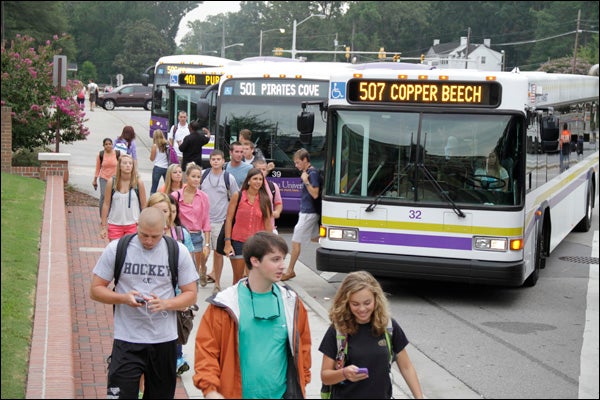TRANSIT TRACKER
Smart bus technology to enhance passenger satisfaction, efficiency
Whether they’re taking a road less traveled or simply running late for class, students at East Carolina University now have an easier way to answer an important question: “When is the next bus coming?”
ECU Transit recently launched Transit Tracker, a passenger information service. Hosted through NextBus, a transit management software company, Transit Tracker allows passengers to access information about what time a bus will arrive at any stop on the ECU system.
“(Students) know the buses that they ride all the time, but (if they) take an exam or class gets out early – this is not the time they typically ride,” explained Wood Davidson, director of ECU Transit. “It’s a system that helps a student who’s on the curb or walking out of class – using whatever technology is available to them – to find out when the next bus is coming.”

An ECU student checks his cell phone messages while waiting for transportation on campus. (Photo by Forrest Croce)
Davidson said any cell phone is compatible with the service, not just smart phones. Transit Tracker can be accessed on a computer via the NextBus web site, by phone call or text, or through ECU’s mobile app.
The technology also enables users to set alarms for regular bus times and receive alerts if a route is delayed or cancelled. One-time, online registration is required to access those services.
Davidson said a couple hundred people are already using the service following a “soft opening” in the fall. More marketing and educational initiatives for students will get under way this semester.
NextBus serves more than 100 university and municipal transit systems including Chapel Hill Transit, the University of Maryland, and both the University of California at Los Angeles and Los Angeles Metro. The widespread usage was part of the service’s appeal.
“If you’re using NextBus here at ECU, you’re also ready if you travel to Chapel Hill or Washington, D.C.,” Davidson said. “It’s not just a contained, ECU-only application.”
Transit Tracker is part of a larger effort bringing “smart bus technology” to ECU. They’ve installed GPS tracking and mapping for the fleet, and electronic logins for bus drivers, automatic passenger counters and video surveillance for each bus.
All these improvements add up to efficiency, Davidson added. It’s easy to tell if certain buses are routinely early or late, and if so, what drivers are responsible. Any complaints from passengers can be quickly vetted with data.
As students begin using Transit Tracker, Davidson asks that they notify ECU Transit of any issues they encounter.
“It’s brand new technology,” he said. “We’ve tried to test it as best we can, but there still will be some bugs…and we need to know about those.”
The first class of freshmen to be introduced to the Transit Tracker will arrive on campus this fall. Student Government Association funds helped to pay for installation.
More information about how to use ECU’s Transit Tracker is available by visiting http://www.nextbus.com/predictor/stopSelector.jsp?a=ecu. The service is also featured on the official ECU application for mobile phones.

Students may obtain information about bus schedules on the Transit Tracker web site, through telephone calls and text or by using a mobile app. (Photo courtesy of Student Affairs)
